Haplochromis sp. Palisa Black Slick
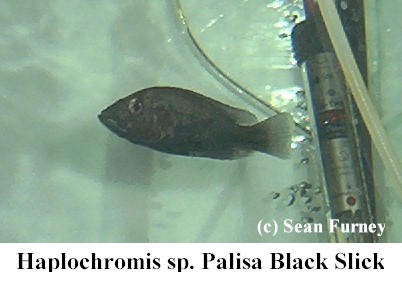

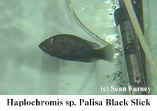

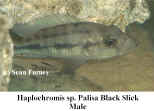

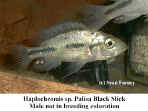

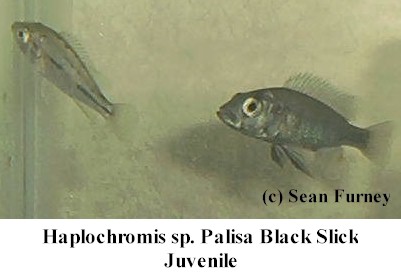

- Common name: This species is also listed under the name Haplochromis sp. Pallisa.
- Location and Lake collected from: Lake Nawampasa
- Approximate size: About 4 inches.
- Food: Mine have eaten flake, daphnia, and frozen brine shrimp without problems. The daphnia and brine shrimp have been their favorite foods that I have tried so far. They hold their weight better by eating 3 or 4 times a day with a higher protein diet.
- pH: 7.6 – 8.4
- Temperature: 75 – 82 degrees F
- Breeding behavior: Mouthbrooder. My male chases the females away from his rock. My males can be very aggressive towards my females while they are brooding. I have to move my brooding females to a separate tank after they spawn. I have only been able to keep 1 male per tank successfully. I have finally gotten the females to hold their eggs past day 8. My female held for 11 – 12 days and had about 12 – 15 fry. My females continue to eat while brooding. The largest spawn size I have gotten from my Palisa’s has been 40 fry from an adult female. Unlike an article that appeared in Cichlid News my Palisas did not pair off and spawn. My female showed only a slight interest in the care of the fry after release, similar to any other mouthbrooding African Cichlid.
- Care of the Fry: Newly released fry can eat crushed flake food, baby brine shrimp, and other small foods. They should be given a minimum of 3 small feedings per day. Palisa fry is larger than the average size for fry from my other Victorians. They are also more sensitive to their water conditions, changes in tank temperature, and the amount they get fed. Small spawns can be kept in a 10-gallon tank up to an inch in size. Males start showing adult coloration at around 2 inches.
- Tankmates: I have mine in with a Haplochromis sp. Tomato male and a Nimbochromis venustus female and have not had any problems.
- Tank size: I am keeping 5 adults in a 20-gallon cube aquarium.
- Additional notes: This fish is often mistaken for the Harpagochromis sp. Golden Duck. Harpagochromis sp. Golden Duck’s are a more elongated fish than the Haplochromis sp. Palisa Black Slicks are. Harpagochromis sp. Golden Duck males when showing breeding coloration lack the blue sheen that Haplochromis sp. Palisa Black Slick males have. Harpagochromis sp. Golden Duck females are more of a yellow color than Haplochromis sp. Palisa Black Slick females.
Further Reading
Below are the few amazing products that will enhance your Aquarium
Read These For Your Aquatic Friends:
👉 Trending
- Aquarium Expedia: How To Care Haplochromis sp. Flameback
- Tiny Fish You Cannot Find In Wild Anymore: More About Haplochromis Guiarti “Red Eye”
- Aquarium Species Profile: How To Care Labeotropheus Fuelleborni
👉 Species Introduction
- Beautiful Electric Blue Species For Your Fish Tank: Sciaenochromis Fryeri
- Synodontis Robertsi Photos
- Altolamprologus Compressiceps Photos
👉 Aquarium Guide
- 4 Best Bio Filtration Products 2023 To Enhance The Water Quality In Your Saltwater Aquariums
- Is Copper Sulphate Safe For Fish Treatment?
- Best Flipper Algae Scraper to Buy
- The Best Pond Vacuums Reviews to Buy In 2023
- Best Fish Aquarium Backgrounds Review 2023
- Can Betta Fish Live With Goldfish? Give reasons why they cannot live together
- Common causes of fish death in an aquarium
- Health Benefits of Fish What are the greatest Health Benefits of Fish?
- How aquarium air pump works / Easy installation process
- Types of Aquarium Sharks/Which are best and which are not
- Why fish tank water is cloudy and how to fix it
- Types of Killifish for Aquarium/ Colorful Killifish
- When should I feed my fish for the Very first time?
- Best Aquarium Cleaning Supplies 2023
- Best Types of Fish Feed/Flakes, Chips, Pellets
- How to Provide the Best Goldfish Care
- Fish Tank Maintenance Tips and Ideas
- Best Fish Food Buying Guide
- Best Aquarium Light Review and Buying Guide
- Best Aquarium Air Pump Review and Buying Guide
- Best Aquarium Filter Pad to buy
- How To Choose The Best Aquarium Canister Filters?
- 5 of the World’s Most Dangerous Lizards and Turtles
- Best Aquarium Air Driven Filters
- Pink Fish Tank Ideas
- Best Reverse Osmosis System
- Best Sand for Saltwater Tank/ Review of Different Products
- Should You Kill Algae In A Saltwater Aquarium Or Reduce It Slowly With These Algae Reducing Tips?
- 4 Recommendations For Saltwater Aquarium Lighting 2023
- How To Choose The Best Amazon Aquarium Air Driven Filters?
- Best Aquarium Product Deals On Amazon Prime Day For Your Aquatic Friends Get The Best Bargain For The Best Quality Now!
- 8 Best Books on Cichlids Of The Lake Victoria Basin
- Water Changes Of Saltwater Aquarium Maintenance
- Saltwater Aquarium Equipment & Tank Setup For Beginners
- How To Choose The Best Amazon Aquarium Internal Power Filters? 2023
- Knowing The Importance Of Filtration: Mechanical, Chemical & Biological Filtration (2023)
- How To Choose The Best Amazon Aquarium Trickle Filters? (2023)
- Decline Of Native Cichlids: The Plight Of The Lake Victoria Species (2023)
- How To Choose The Best Amazon Aquarium Protein Skimmers?
- How Do Magnetic Impellor Driven Pumps Function?
- Everything You Need To Know About Aquatic Filtration: FAQs on Pumps, Protein Concentration And Dangers (2023)
- Saltwater Aquarium Backup
- So You Want To Start An Aquarium?
- How To Choose The Best Amazon Aquarium Undergravel Filters?
- How To Choose The Best Aquarium Power Filters? 2023
- What Is A Nano Tank Aquarium? – Beginner Guide 2023
- How To Keep Marine Fish? – Marine Fish Care Tips For Beginners
- Coolest Freshwater Aquarium Fish For Beginners
- All The Best Aquarium Gifts/Deals For Saltwater And Fresh Water Aquatic Animals 2023
- Aquarium Fish and Aquarium Heating Tips For Aquarians (FAQs 2023)
- Best Aquarium Heater 2023: 7+ Most Reliable Brand For Maintaining Water Temperature with No Trouble
- Fixing Problems Of Your Aquarium Magnetic Impeller Driven Pumps (2023)
- Water Changes Tips For Aquarium: How much Filtration Is Required?
- 11+ Best Aquarium Accessories & Essential Fish Tank Accessories.
- How To Get Rid Of Fungus In Turtles? Symptoms And Treatments
- Why Is My Turtle Not Active Nor Responding? Understanding Potential Turtle Problems FAQ-4 (2023)
- 9 Steps To Change the Water Of the Fish Tank
- These Saltwater Aquarium Tips Can Prove Incredibly Helpful To You 2023
- Best Hanging Filtration System
- Best Phosphate Remover: 3 Recommendations For Your Fish Tank
- Aquatics Of Cichlid: Profile You Should Read About Labrochromis Ishmaeli
- Most Asked Questions about a Freshwater Aquarium
- Here Is How To Calculate The Volume And Surface Area Of Your Aquarium
👉 Water Heating Products And Info
- 11+ Best Aquarium Accessories & Essential Fish Tank Accessories.
- Best Aquarium Product Deals On Amazon Prime Day For Your Aquatic Friends Get The Best Bargain For The Best Quality Now!
- All The Best Aquarium Gifts/Deals For Saltwater And Fresh Water Aquatic Animals 2023
👉 Water Pump Products And Info
- Fixing Problems Of Your Aquarium Magnetic Impeller Driven Pumps (2023)
- 11+ Best Aquarium Accessories & Essential Fish Tank Accessories.
- All The Best Aquarium Gifts/Deals For Saltwater And Fresh Water Aquatic Animals 2023
👉 Aquarium Filter And Info
- Water Changes Tips For Aquarium: How much Filtration Is Required?
- How To Choose The Best Amazon Aquarium Trickle Filters? (2023)
- Why Is Filtration Necessary? – The Biology Of The Aquarium (2023)
👉 Turtle Guides
- Why Is My Turtle Not Active Nor Responding? Understanding Potential Turtle Problems FAQ-4 (2023)
- How To Set The Best Aquarium Environment For Your Freshwater Turtles FAQ-2 (2023)
- How To Get Rid Of Fungus In Turtles? Symptoms And Treatments
👉 Water Plants
- Basic Knowledge About Aquatic Plant “Mondo Grass”
- Free Aquarium Planting Cheat Sheet 2023: The Guide To Aquascaping Basics – Styling Planting And Maintaining Your Underwater Paradise
- Bulb Plant For Your Aquarium: Aponogeton Ulvaceus Care Guide
👉 Fresh Water Aquarium Guides
- Knowing The Importance Of Filtration: Mechanical, Chemical & Biological Filtration (2023)
- 4 Best Bio Filtration Products 2023 To Enhance The Water Quality In Your Saltwater Aquariums
- Is Copper Sulphate Safe For Fish Treatment?
- Best Flipper Algae Scraper to Buy
- The Best Pond Vacuums Reviews to Buy In 2023
- Best Fish Aquarium Backgrounds Review 2023
- Can Betta Fish Live With Goldfish? Give reasons why they cannot live together
- Common causes of fish death in an aquarium
- Health Benefits of Fish What are the greatest Health Benefits of Fish?
- How aquarium air pump works / Easy installation process
- Types of Aquarium Sharks/Which are best and which are not
- Why fish tank water is cloudy and how to fix it
- Types of Killifish for Aquarium/ Colorful Killifish
- When should I feed my fish for the Very first time?
- Best Aquarium Cleaning Supplies 2023
- Best Types of Fish Feed/Flakes, Chips, Pellets
- How to Provide the Best Goldfish Care
- Fish Tank Maintenance Tips and Ideas
- Best Fish Food Buying Guide
- Best Aquarium Light Review and Buying Guide
- Best Aquarium Air Pump Review and Buying Guide
- Best Aquarium Filter Pad to buy
- How To Choose The Best Aquarium Canister Filters?
- 5 of the World’s Most Dangerous Lizards and Turtles
- Best Aquarium Air Driven Filters
- Pink Fish Tank Ideas
- Best Reverse Osmosis System
- Best Sand for Saltwater Tank/ Review of Different Products
- Should You Kill Algae In A Saltwater Aquarium Or Reduce It Slowly With These Algae Reducing Tips?
- 4 Recommendations For Saltwater Aquarium Lighting 2023
- How To Choose The Best Amazon Aquarium Air Driven Filters?
- Best Aquarium Product Deals On Amazon Prime Day For Your Aquatic Friends Get The Best Bargain For The Best Quality Now!
- 8 Best Books on Cichlids Of The Lake Victoria Basin
- Water Changes Of Saltwater Aquarium Maintenance
- Saltwater Aquarium Equipment & Tank Setup For Beginners
- How To Choose The Best Amazon Aquarium Internal Power Filters? 2023
- How To Choose The Best Amazon Aquarium Trickle Filters? (2023)
- Decline Of Native Cichlids: The Plight Of The Lake Victoria Species (2023)
- How To Choose The Best Amazon Aquarium Protein Skimmers?
- How Do Magnetic Impellor Driven Pumps Function?
- Everything You Need To Know About Aquatic Filtration: FAQs on Pumps, Protein Concentration And Dangers (2023)
- Saltwater Aquarium Backup
- So You Want To Start An Aquarium?
- How To Choose The Best Amazon Aquarium Undergravel Filters?
- How To Choose The Best Aquarium Power Filters? 2023
- What Is A Nano Tank Aquarium? – Beginner Guide 2023
- How To Keep Marine Fish? – Marine Fish Care Tips For Beginners
- Coolest Freshwater Aquarium Fish For Beginners
- All The Best Aquarium Gifts/Deals For Saltwater And Fresh Water Aquatic Animals 2023
- Aquarium Fish and Aquarium Heating Tips For Aquarians (FAQs 2023)
- Best Aquarium Heater 2023: 7+ Most Reliable Brand For Maintaining Water Temperature with No Trouble
- Fixing Problems Of Your Aquarium Magnetic Impeller Driven Pumps (2023)
- Water Changes Tips For Aquarium: How much Filtration Is Required?
- 11+ Best Aquarium Accessories & Essential Fish Tank Accessories.
- How To Get Rid Of Fungus In Turtles? Symptoms And Treatments
- Why Is My Turtle Not Active Nor Responding? Understanding Potential Turtle Problems FAQ-4 (2023)
- 9 Steps To Change the Water Of the Fish Tank
- These Saltwater Aquarium Tips Can Prove Incredibly Helpful To You 2023
- Best Hanging Filtration System
- Best Phosphate Remover: 3 Recommendations For Your Fish Tank
- Best Ways To Keep Brine Shrimp For Fish Food
- Profile Of Tanganyika Clown: How To Care Eretmodus Cyanostictus
👉 Marine Aquarium Guides
- 4 Recommendations For Saltwater Aquarium Lighting 2023
- Here Is How To Calculate The Volume And Surface Area Of Your Aquarium
- Saltwater Fish Profile: Tips You Should Know To Breed Haplochromis sp. Salmon
👉 Other Essential Products